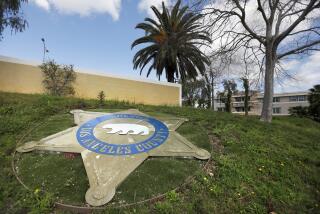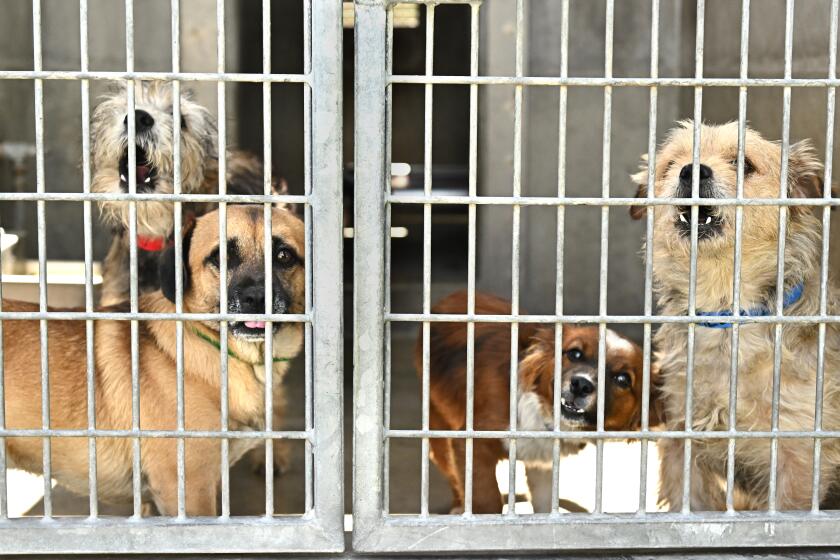Death takes a holiday at shelters
On any given day in the six city-run animal shelters, there are roughly 1,000 dogs, cats and rabbits, most available for adoption. On average, 56 are adopted daily and 50 are euthanized -- or killed, as private animal welfare groups bluntly put it.
A “no-kill” policy is the holy grail for municipal shelters nationwide. But it’s something that few big cities have been able to accomplish, despite increasing pressure from animal welfare groups to stop the euthanasia of healthy animals and, ultimately, many animals with health or behavior problems.
So, with much promotional fanfare, the city of Los Angeles is taking a small experimental step toward that elusive goal. The city has proclaimed today through Sunday a “No-Kill Weekend.”
“This is our declaration that death is taking a holiday,” said Ed Boks, general manager of the city’s Department of Animal Services.
But can a brief holiday from euthanasia get the city closer to its goal?
Maybe, said Boks, suggesting that the moratorium could continue beyond Monday, when the shelters are closed to the public and generally don’t euthanize healthy animals.
“Our hope is that there will be such an overwhelming response from the public that this moratorium will continue into four weeks or months,” Boks said, adding that he hoped the moratorium could at least extend through the week.
Scott Sorrentino, co-founder and president of the Rescue & Humane Alliance-Los Angeles, the originator and one of the private partners in the weekend “no-kill” venture, did not want to make a prediction.
“Would we like them to say eight days or 12 days or 16 days or three months?” Sorrentino asked. “Of course. But let’s start with four [days].”
The sponsoring organizations are working hard to attract prospective pet owners. Billed as the “Paw-fect Match Super Adoption” weekend, the six city shelters will offer discounted adoption fees, volunteer “matchmakers” (to pair the right animal with the right human) and, on Saturday, some of the city’s best-known trainers, including Cesar Millan of television’s “Dog Whisperer.” Millan will be at the South Los Angeles shelter from noon to 2 p.m. Adoptions aren’t limited to L.A. residents.
But more intriguing than all the marketing hoopla is the idea of publicizing that the shelters are taking a break from euthanasia -- and letting people know that if the event is wildly successful, the hiatus might continue.
“Obviously you can’t blame them for trying,” said Madeline Bernstein, president of the Society for the Prevention of Cruelty to Animals of Los Angeles, which runs three shelters and has a 90% adoption rate.
“I think it’s great if it opens the dialogue, if it gets people thinking, if it gets people talking. What’s not good is if the animals [are returned] after the no-kill weekend. What’s not good is if this is not accompanied by a long-term strategy.”
Bernstein added: “Sometimes you’ve got these giant weekends where they say 400 were adopted, then 398 come back on Monday.”
This weekend’s event is “awareness-raising more than anything,” said Cheri Shankar, founder and vice president of Shelter Animals of Los Angeles, the other private partner. “A lot of people don’t know that the shelters are there. And they don’t know that the shelters euthanize animals. They think the shelters keep the animals forever.”
Sorrentino doesn’t mince words: “We want the words ‘no-kill’ to start becoming part of the discussion in the community about shelter animals.”
He said everyone can play a role in reducing animal euthanisia.
“How might you be able to help indirectly? If one of your friends was to tell you that they’re going out to buy a Jack Russell terrier for $600, would you sit there quietly and say, ‘That’s nice.’? Or would you give them a lecture on how they should go to the shelter? Just that one conversation may save an animal’s life.”
The participants in the event insist that adoptions are only part of the solution. Said Sorrentino: “It really comes down to three things: spaying and neutering, really innovative pet retention programs to dramatically reduce impounds, cutting-edge adoption programs to increase adoptions.”
Bernstein’s long-term strategy echoes Sorrentino’s and emphasizes that owning an animal is a long-term commitment. “You have to get people to stop treating their animals like Doritos,” she said.
There are precedents for the “No-Kill Weekend.” Animal Services declared a weekend moratorium at the North Central shelter last fall. And Boks instigated a “Cat-tastrophe” event to halt the euthanasia of cats for several days last spring during the traditional birthing season. (The city shelter system euthanizes a little more than half the cats it receives.) And when he ran the New York City Department of Animal Care and Control, Boks instituted a brief moratorium on euthanasia.
San Francisco’s shelter system is often considered a model, but its director said the city does not have a no-kill policy.
“We are a very low-kill city,” said Carl Friedman, director of the Department of Animal Care and Control since 1988. “We are working to become a no-kill city. But we think our live release rate is one of the best if not the best.”
San Francisco “releases” (adopts out or returns to owners) 82% of its impounded animals and does not euthanize animals considered “adoptable” -- an increasingly debated term among animal welfare advocates.
“I can put 10 people in a room and get you 15 different answers to that,” Friedman said.
He applauded L.A.’s weekend event.
“I don’t want to diminish it by saying it’s marketing, but in a sense we have a product we need to get out to people. We need to show how great that product is.... Anything that you can do to bring up awareness of the problem of animals being euthanized or killed because there are not enough homes or enough space is great.”
*
More to Read
Start your day right
Sign up for Essential California for news, features and recommendations from the L.A. Times and beyond in your inbox six days a week.
You may occasionally receive promotional content from the Los Angeles Times.







